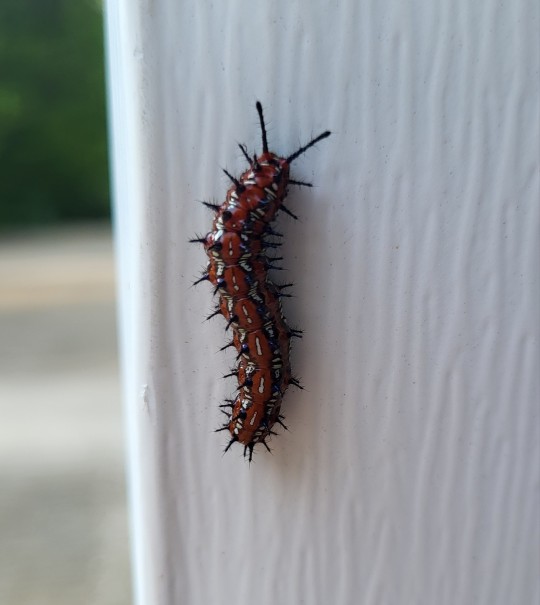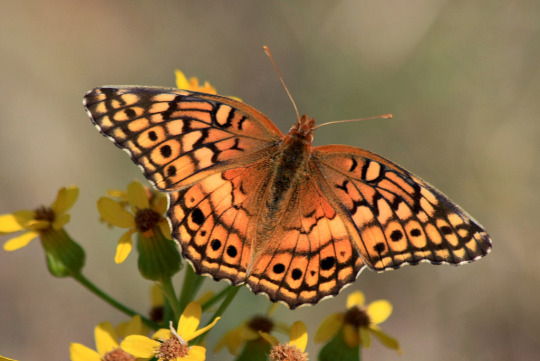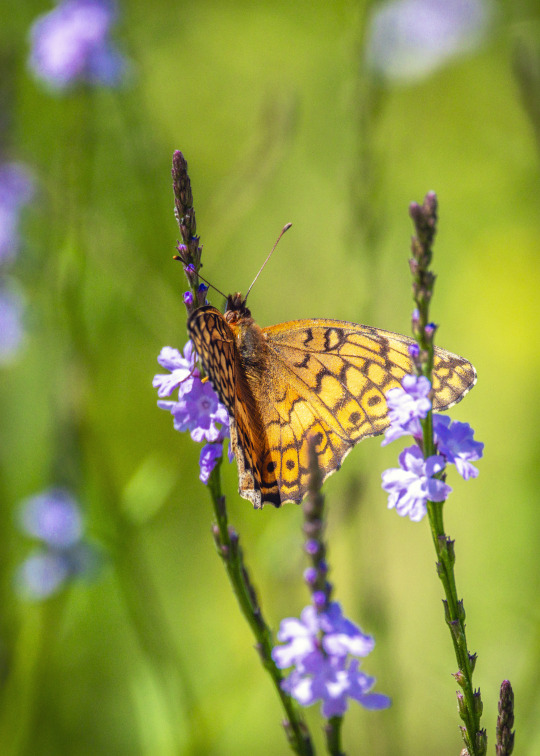#variegated fritillary
Explore tagged Tumblr posts
Text
@lorianlilsiel submitted: Found this little guy in the [removed] area (please remove location) and wondered what he'll turn into!

What a fancy, fashionable child! Looks like a variegated fritillary caterpillar. Here's an adult:

Photo by Ken Slade
203 notes
·
View notes
Text


Variegated fritillary
#variegated fritillary#fritillary#butterfly#bugblr#insectblr#bug#insect#animal#wildlife#photo#photography#original photography#lavender nightjar photography#animal photography#bug photography#insect photography#wildlife photography#butterfly photography#macro#macro photography#photographers on tumblr#photographers of tumblr
41 notes
·
View notes
Text




Such a charming & beautiful butterfly
Sunday August 25th 2024 2:05pm
#2024#august#euptoieta claudia#variegated fritillary#animals#insect#insects#butterflies#butterfly#marigolds#marigold#bug#hugs#flower#Flowers
31 notes
·
View notes
Text

You and those variegated fritillaries
#my art#variegated fritillary#butterflies#butterfly#butterfly art#watercolor#watercolor painting#painting#ink drawing#original art#art#traditional art#scientific illustration#illustration#animals#animal art#insects#insect art#entomology#ecology
71 notes
·
View notes
Text

Saw this caterpillar on the side of the house yesterday and almost picked him up before I realized he looked like he might be getting ready to cocoon. Today he's halfway there!
7 notes
·
View notes
Text

9 notes
·
View notes
Text
i have to say, even after many years, i still remember how i cared for two caterpillars that successfully turned into butterflies. i really hope to come across more next year.
here are the ones that i raised before:


the first one is known at the Painted Lady, the other is Variegated fritillary.
i had the most fun with the Variegated fritillary, seeing their chrysalis from an interesting perspective as i have never encountered ones with such cool and shiny designs.

like, excuse me?! just beautiful, honestly. ❤️🦋
0 notes
Text

Chronic depression sucks... here's a bug
1 note
·
View note
Text
First of all, here's a purple passionflower (Passiflora incarnata), from the same plant this fruit came from. Not the same flower, though, since this flower just opened today, and I got that ripe fruit yesterday.

[ID: A photograph of a purple passionflower flower, hangong on a vine growing up a string trellis on a wooden fence. The flower is covered in lavender yellow tendrils which twist and curve, with a darker stripe of purple near the center before they turn white. The center of the flower where its reproductive parts are stands up above the tendrils, and has pale yellow parts doted with tiny red spots. The leaves are dark green, with three distinct lobes and rounded serrated edges. End ID.]
And here's what the leaves look like:

[ID: A photo of purple passionflower leaves on a vine above the grass. They leaves have three distinct lobes, with rounded-serrations along the edges, and alternate in a zig-zag pattern along the stem. At the base of the leaves are thin tendrils which are hanging down into the grass. End ID.]
This species gets its name from its purple flowers, rather than the fruit being purple. Nope, it stays green the whole time, you know it's ripe when it falls off.
You don't eat the skin (As far as IK, it could be edible, I'm going to find out), you just pull it open and eat the seeds and the flesh around them, like a pomegranate but not the most inconvenient thing you've ever eaten in your life.
Edit: Yes, you can eat the outside too!
You don't even need a knife. The skin is sort of papery and will just pull part. They're also super light weight, and you don't have to worry about bruising them unless you squashed it entirely flat lol.
These are sometimes called Maypop passionflower/passionfruit because, since they ripen to green and fall off, you're likely to step on them. They've got air inside them, so if you step on them they'll make a popping noise kind of like a balloon.
I tried to demonstrate that in the video I made but it just made a soft puffing sound instead lol. Camera shy I guess.
Also I just bothered to actually look up the scientific name for these sacs of fruit around the seeds, they're called arils!

[ID: Two photos. The first shows a white hand over a wooden bench holding a ripe purple passionflower fruit. The fruit fits in the palm of the hand, and has a light green, papery skin, with a short stem still attached to the top. Some indentations are visible on the surface. The next photo shows the fruit opened, revealing that the inside of the skin is white, with most of the space taken up by the pale yellow, transparent sacs of fruit, or arils, around the black seeds, which are visible inside them. And ID.]
Since this species is completely wild, each passionflower plant will produce uniquely flavored fruit, overall sharing general characteristics, but slightly different each time.
This fruit has a soft sweetness on the outside of each aril, followed by a slightly sour (in a good way, not a gross way)...maybe the word I'm looking for is tangy flavor when you bite down or squish it.
I don't really have anything to compare the main flavor to, since no other fruit I've eaten has tasted like this. It reminds me of candy. It's really freaking good, and has a mild aftertaste of the same flavor.
I ate the arils one at a time so I could make sure not to swallow the seeds, since we want to plant and grow every single one of them, but if you've already saved seeds, you can eat them too, just like with pomegranates.
If you're keeping them, the seeds can be planted at any time. They'll sprout when it's nice and warm.
These plants are native to eastern North America, reaching all the way down into Florida, and as far north as southern Pennsylvania, and over to eastern Oklahoma and Texas.
You can find a map of observations of them here on iNaturalist.org You can zoom in to see if there's any growing wild near you!
If you want to grow your own and there are wild ones near you, you can collect ripe fruit off the ground, eat the pulp off the seeds, and plant the seeds, or look around the ground by the wild plant, and see if there are any new stems popping up.
Purple passionflowers spread themselves naturally through root runners or root suckers, looking for more places to climb and grow.
This plant is a perennial, meaning it will come back year after year, as opposed to an annual, which only grows for one year before dying.
Each year the stems die back to the ground, where the roots will stay dormant over the winter months, before reemerging in late spring, and spending the summer growing.
If you find new stems popping up from a wild plant, especially if they're out in the open with nothing to climb, or where you know they will be mowed down, if you have a container to keep them in until they can be planted, (A zip lock bag with water or a wet paper towel, or a plastic bottle tall enough to fit the stem in will work) and little shovel or a stick, you can dig up these stems and transplant them where you want them to grow. Try to get as much of the rooty part of the stem as possible, which will be white or lighter green than above the surface.
Transplant directly into the ground, or a larger plant pot, as soon as possible, water it well, and try to keep it in the shade for the first few weeks, or tie a clear plastic bag, or plastic container over top to act as a greenhouse so it doesn't dry out. Or put it in an actual greenhouse if you have one.
Transplanting root suckers works best in spring, since it's not too hot yet, but can be done any time of the year as long as you take care of the clones and make sure they get enough water.
If your cutting is in a plant pot, once it starts actively growing again, you can transplant it to wherever you want it to go.
If you want to grow it in a plant pot, a five gallon bucket like they sell at Home Depot or Lowes, with holes drilled in the bottom for drainage, and some good, not absurdly heavy potting soil, will work great, and if you can get a bigger pot, even better! Just make sure you mulch it and give the vine something to climb!
A chain link fence, chicken wire, or even just string tired to a wooden fence will work, or if you've got some tall sunflowers or other sturdy plants, like a bush, it can climb those too!
This species, and other north-america native passionflowers, are also the host plant for at least six different species of butterflies, meaning the adults lay their eggs on the leaves, and the caterpillars eat the leaves (and sometimes the flower buds), which is another reason the plant grows so quickly.
If you see caterpillars on your plant, rejoice! You have provided a cradle for a native butterfly species!
If your plant is already established, continue to rejoice. It will be more than capable of bouncing back and growing new leaves to replace the ones the caterpillars eat.
If they are on a young cutting or seedling, you may want to gently move them to a stronger plant if you have one, which can include wild passionflowers if there are any in your immediate area!
So far I have seen gulf and variegated fritillary caterpillars, and zebra longwing caterpillars!
This photo shows a zebra longwing caterpillar (white) and gulf fritillary caterpillar (orange) sharing the leaf of a yellow passionflower:

[ID: A photo of the underside of a yellow passionflower leaf, behind held by the thumb and forefinger of a white hand. Two spiky caterpillars cling to the underside, both smaller than the thumbnail. On the left is a zebra longwing caterpillar, which is white with black spots and spikes. On the right is a gulf fritillary caterpillar, which is orange with black spikes and some darker stripes. End ID.]
Here's a variegated fritillary caterpillar:

[ID: A close up photo of a variegated frillary caterpillar on a purple passionflower plant. The caterpillar has a red body, black spikes, and black and white stripes of connected spots going up and down its body. Its face and legs are black, and it has two taller spikes above its hear. End ID.]
If your plant is very small, it may get all its leaves eaten, but it should grow them back after the caterpillars form their chrysalises. Just keep watering it like normal, assuming it's not raining every day. (For posterity, it's June 25th 2023 as I am typing this, and it's rained almost every single day for the last two weeks. There were literally thunderstorms seven days in a row.)
If you have the option, planting purple passionflower directly into the ground is the ideal, since this will let it spread further out through the root suckers, though as I said before, it can be grown in a five gallon bucket with no problem.
We had one growing in the ground in Pennsylvania, which flowered, and grew very big, but never formed fruit. I'm not sure if the bees weren't pollinating the flowers properly, or what, but all our plants in Georgia now, including a clone of the one we had in PA, are much happier and set fruit easily.
In Georgia, they can start forming flower buds in late March. Our earliest flowers so far were on April 28th, with fruits becoming noticeable in May. Each individual plant will be different, though, and their characteristics will likely change with your environment, so you'll have to keep track of when yours do what!
#long post#Purple passionflower#purple passionfruit#Passionflower#passionfruit#passiflora#passiflora incarnata#bugs#insects#baby bugs#caterpillars#bug photos#insect photos#caterpillar photos#gulf fritillary#variegated fritillary#zebra longwing#butterflies#host plants#wild edibles#wild fruit#wildlife#gardening#Rjalker trains its gardening skill#Georgia native plants#North America native plants#wild foraging#very long post#fruit#food
0 notes
Text

Variegated Fritillary on wildflowers in the Brazoria National Wildlife Refuge in Texas
#photographers on tumblr#original photographers#nature photography#texas photographer#texas#wildflowers#original photography on tumblr#butterlly
62 notes
·
View notes
Note


May I ask who is inside this lovely gold and silver cocoon currently on my apartment doorframe? (St Louis area)
Euptoieta claudia, variegated fritillary seems closest
100 notes
·
View notes
Text




Butterflies I have seen this summer! I believe they are (top right to bottom left), a Hackberry Emperor, a Variegated Fritillary, a Pipevine Swallowtail, and a small white. 💕
20 notes
·
View notes
Text
Not doing too much in the way of caterpillar raising at the moment, but I did pick up some variegated fritillaries, and you all simply MUST see how pretty their little pupae are:




149 notes
·
View notes
Text

Adventurous lil bud
Sunday August 25th 2024 2:08pm
#2024#august#animals#flowers#flower#butterflies#butterfly#Euptoieta claudia#variegated fritillary#insect#insects#bug#bugs
16 notes
·
View notes
Text





Pics of the variegated fritillary I pinned in my last post! Had a blast playing around with lights and shadows for these photos.
#vulture culture#vulture culture collection#oddities and curiosities#entomology#butterfly#insect pinning#pinned insects
17 notes
·
View notes
Text
I’ve been feeding two variegated fritillary butterfly caterpillars that I found in my garden (they’re pretty common) and they pupated into the most beautiful little chrysalises! They look like antique glass Christmas ornaments, iridescent and shiny.






7 notes
·
View notes